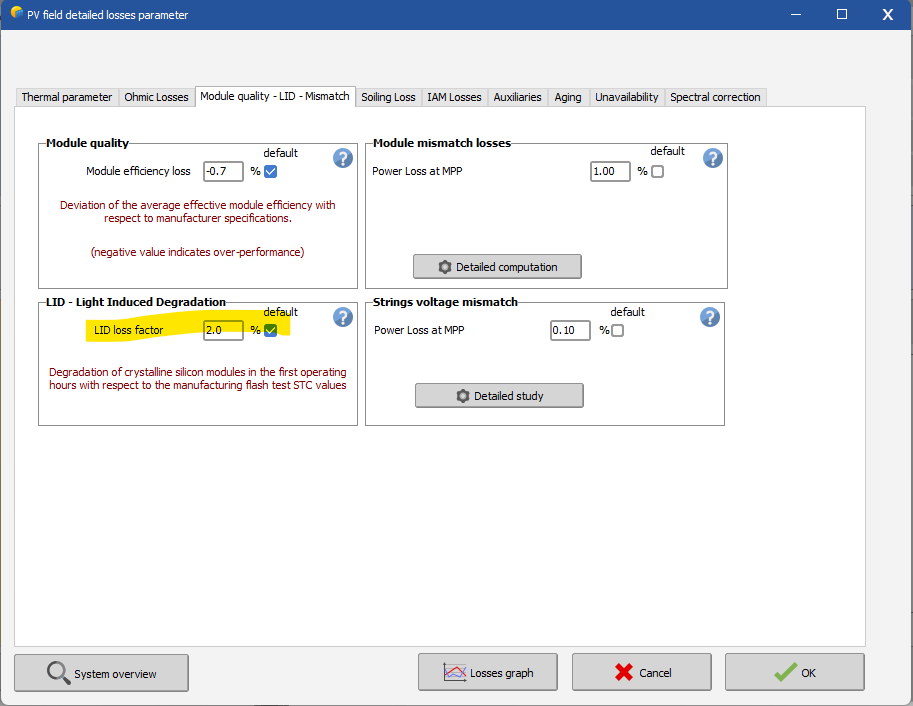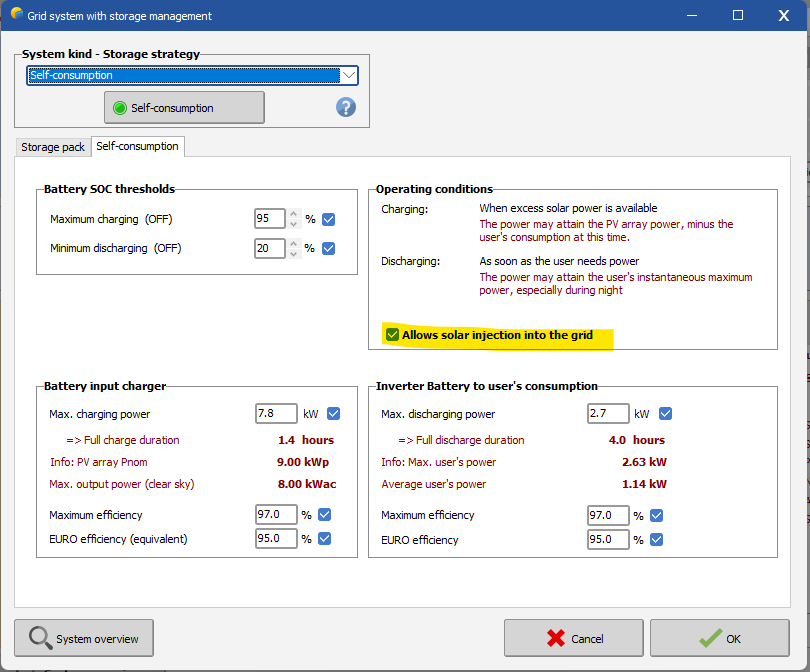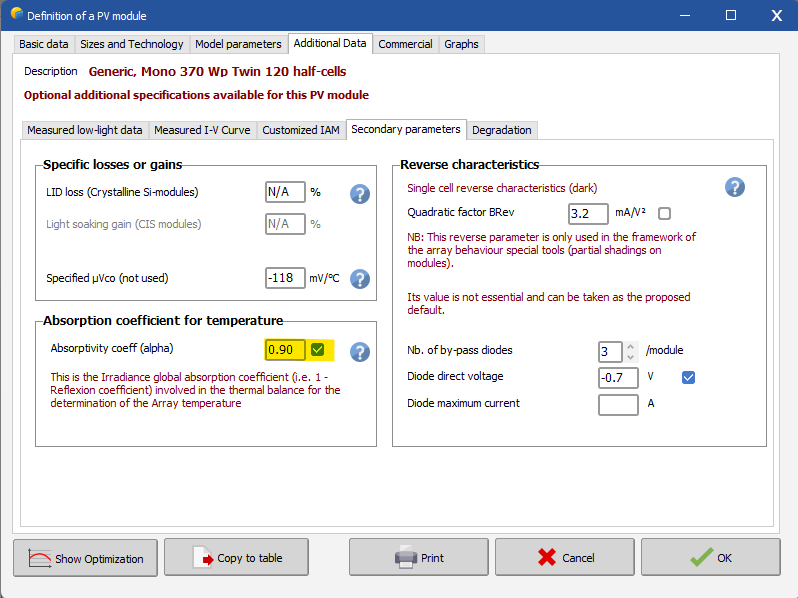-
Posts
785 -
Joined
-
Last visited
Everything posted by Michele Oliosi
-
A warranty cannot be used in the simulation. It is a warranty, i.e., commercial information. It does not really reflect a module degradation. Besides, the downwards slope is not easily readable from the graph but would be about 0.7%/year, which, as mentioned, would be overly pessimistic if it was a real degradation rate.
-
Hi, first, please be careful that the warranty specifications on a datasheet are not equivalent to the degradation factor. The warranty specifications are usually a bit pessimistic. Then, the first year degradation factor is likely due to LID of 3%. You can define an LID of about 3%, and use only the 0.3%/year in the degradation window.
-

PV System withou injection energy to grid
Michele Oliosi replied to Michalis Angeli's topic in Simulations
In this case please go on with "Grid connected" and not "Standalone". In the storage strategy you have the option to allow or forbid the solar energy injection into the grid. -
The important point to clarify is what a configuration means: it is a certain number of inverters that have exactly the same strings & MPPT configuration. Among your 7 inverters, there may be a subset (for example 3) that share in the same strings & MPPT configuration. Then in the sub-arrays that refer to this configuration, you should have a multiple of the number of MPPT in this configuration (in the example 3). It is essential to separate the total number of inverters in your system, from the number of inverters in a given configuration. Indeed, this check is relatively new. However, this means that some incorrect situations were allowed in the past.
-

Outlier treatment using non-linear regression
Michele Oliosi replied to Rafael Vilela's topic in Simulations
When importing custom data, PVsyst will test whether irradiances are between -28 W/m^2 and 1600 W/m^2. If the irradiances are out of these bounds, they are considered 0. If you want to use the data in PVsyst, I would suggest using your filters for outliers before importing in PVsyst. Finally, the sine may work ok for clear sky conditions, but how do you account for overcast conditions ? -
There is the problem of sun direction, I think doing this would get that incorrectly. However you can split in several files for each minute stamp and simulate each one with the proper time shift, that should do the trick.
-

PV System withou injection energy to grid
Michele Oliosi replied to Michalis Angeli's topic in Simulations
If your system does not exchange energy with the grid, it means that the grid will only be there as a backup to cover for excess load, is that right? What about times when the batteries are fully charged? -
Can you send us the CSV to support@pvsyst.com ? We will try to find the issue.
-
In the source CSV, can you try putting "Date" and "Load" on the same line ?
-

Bifacial modeling with shading scene
Michele Oliosi replied to Pranav Maheshwari's topic in Problems / Bugs
Yes, can follow the method. I would suggest combining your idea with my previous comment, i.e., using the 3D scene variant, but choosing only a single orientation. This would be the second simulation. It is likely a bit more precise than the simulation with unlimited sheds. -

PV System withou injection energy to grid
Michele Oliosi replied to Michalis Angeli's topic in Simulations
You should design a “Stand-alone system” in this case. -
Usually the default value is what is pre entered in PVsyst when you open the window. In this case, it would be 0.4%/year. You can also check the help for more details.
-
I think these were just example values. Unless you have information from a research group / lab / measurements, I would recommend to just leave the default values.
-
-
This is coincidental, the two are not related.
-
No, as stated in orange, this is not necessary unless you are doing a very specific aging study and need a degraded module.
-
Please read https://www.pvsyst.com/help/ageing_general.htm The black values (%) are calculated from the red values (%/year). Since we calculate in the middle of the year (1/2 year mark), 0.5%/year means 0.25% for the simulation. To this, the mismatch degradation values are added, which are calculated from a series of random samples. By the way, your mismatch loss seems wrong. Please uncheck “keeps calculated mismatch values” and click on “add statistics” a couple of times. You can then resave the model.
-

Bifacial modeling with shading scene
Michele Oliosi replied to Pranav Maheshwari's topic in Problems / Bugs
Hi Actually, this is a misconception shared among many users. You can simulate with the bifacial model and a 3D shading scene ! However, there are conditions on the shading scene for this to work https://www.pvsyst.com/help/bifacial-conditions.htm The main issue in your case is that you don't have multiple rows of tables, but just a single row. Besides, the tables are not the same width. This will prevent from using the bifacial model jointly with the 3D scene. I would suggest the following: Make a variant without the small table. Replace the other 11 modules by a single 6 by 2 table. Duplicate the whole scene and place the copy far away to the northwest. This will mimic a second row and trick PVsyst to let you use the bifacial model. But because the second table is so far away, they won't affect each other. You should use the shading mode “according to module strings”. Because the number of modules is not the original one, using the detailed electrical calculation is not possible. -
Natural or forced air circulation. If the modules and roof are flush: fully insulated If there are a couple centimeters between modules and the roof : semi-integrated
-

Electrical loss according to string - Tracking systems
Michele Oliosi replied to gpuy's topic in Shadings and tracking
In the end, the results were consistent with the backtracking (on flat ground, therefore ShdElec = 0). So no issue after all. Did anyone experience the same issue ? Or were you following by interest ?- 8 replies
-
- backtracking
- near shadings
- (and 3 more)
-
Basically, if there is no air circulation at the back of modules.
-
If the modules have some air duct at the back, it should count as semi-integration.





